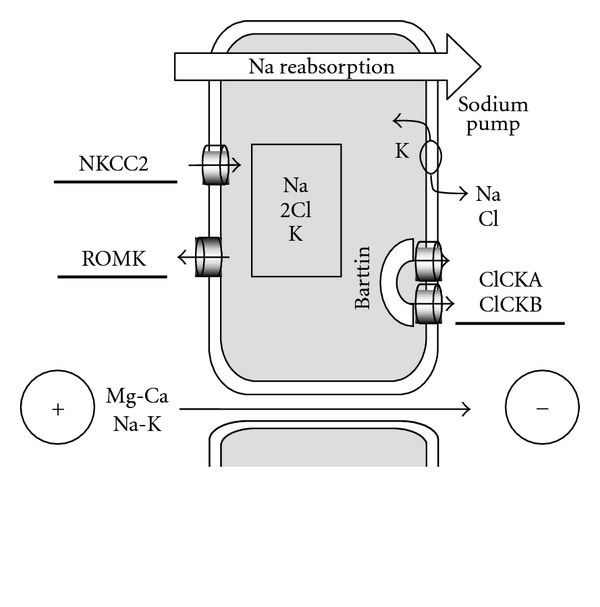Figure 2.

Structures involved in sodium reabsorption in the Henle loop. The large part of the Henle loop is mainly dedicated to sodium reabsorption. The system is vectorized and energized by the sodium pump at the basolateral face of the cell. KCNJ10 (not drawn on the figure) is supposed to recycle potassium at the basolateral face of the cell allowing fueling of the sodium pump in extracellular potassium. At the apical face, the sodium is cotransported with 1 potassium and 2 chlorides by the NKCC2 cotransporter. The four sites of the NKCC2 have to be occupied to generate an electroneutral transport. As the urinary fluid is 30-fold more concentrated in sodium than in potassium, potassium ions are recycled in the urine fluid at the luminal face of the cell through the ROMK (rectified outer medullary potassium) channel, in order to provide enough potassium for a continuous activity of the NKCC2. The 2 chlorides are reabsorbed at the basolateral face of the cell by the chloride channels CLCKA and B. Those channels need to be addressed and clustered at the basolateral membrane by the barttin. The main regulator of sodium reabsorption in the Henle loop is the vasopressin (also referred as antidiuretic hormone). The asymmetry of charges in the lumen (excess of potassium) and in the interstitium (excess of chloride) generates a potential according to the 3rd principle of thermodynamics (Nernst formula). The paracellular transport of cations (calcium and magnesium as well as sodium and potassium in some extent) through the intercellular space is allowed by special claudins (claudines16 and 19, also referred as paracellins) and dissipates the transepithelial potential of the Henle loop [2, 3].
